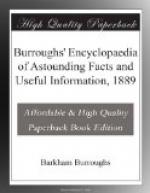LEANING TOWER OF PISA.—The leaning tower of Pisa was commenced in 1152, and was not finished till the fourteenth century. Tho cathedral to which this belongs was erected to celebrate a triumph of the Pisans in the harbor of Palermo in 1063, when allied with the Normans to drive the Saracens out of Sicily. It is a circular building, one hundred feet in diameter and 179 feet in extreme height, and has fine mosaic pavements, elaborately carved columns, and numerous bas-reliefs. The building is of white marble. The tower is divided into eight stories, each having an outside gallery of seven feet projection, and the topmost story overhangs the base about sixteen feet, though, as the center of gravity is still ten feet within the base, the building is perfectly safe. It has been supposed that this inclination was intentional, but the opinion that the foundation has sunk is no doubt correct. It is most likely that the defective foundation became perceptible before the tower had reached one-half its height, as at that elevation the unequal length of the columns exhibits an endeavor to restore the perpendicular, and at about the same place the walls are strengthened with iron bars.
What causes the water to flow out of an artesian well?—The theoretical explanation of the phenomenon is easily understood. The secondary and tertiary geological formations often present the appearance of immense basins, the boundary or rim of the basin having been formed by an upheaval of adjacent strata. In these formations it often happens that a porous stratum, consisting of sand, sandstone, chalk or other calcareous matter, is included between two impermeable layers of clay, so as to form a flat [Transcriber’s




